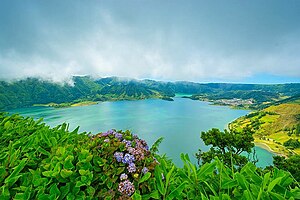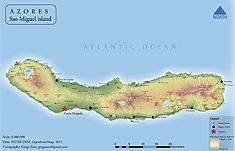São Miguel Island
| São Miguel (Ilha de São Miguel) | |
| The "Green" Island | |
| Island (Ilha) | |
|
The Sete Cidades lagoon in São Miguel Island.
|
|
| Official name: Ilha de São Miguel | |
| Name origin: Portuguese for Saint Michael | |
| Nickname: Ilha Verde | |
| Country | Portugal |
|---|---|
| Autonomous Region | Azores |
| Islands | Eastern Group |
| Location | Azores Platform, Mid-Atlantic Ridge, Atlantic Ocean |
| Municipalities | Lagoa, Ponta Delgada, Povoação, Nordeste, Ribeira Grande, Vila Franca do Campo |
| Civil Parishes | (see text) |
| Highest point | Pico da Vara |
| - location | Planalto dos Graminhais, Nordeste |
| - elevation | 1,104.74 m (3,624 ft) |
| - coordinates | 37°48′35″N 25°12′51″W / 37.80972°N 25.21417°W |
| Lowest point | Sea level |
| - location | Atlantic Ocean |
| - elevation | 0 m (0 ft) |
| Length | 63.54 km (39 mi), Northwest-Southeast |
| Width | 15.63 km (10 mi), Southwest-Northeast |
| Area | 744.55 km2 (287 sq mi) |
| Population | 137,830 (2011) Census 2011 |
| Density | 185.1/km2 (479/sq mi) |
| Biomes | Temperate, Mediterranean |
| Geology | Alkali basalt, Tephra, Trachyte, Trachybasalt |
| Orogeny | Volcanism |
| Period | Holocene |
| Demonym | Micaelense |
| Ethnic groups | Portuguese |
|
Physical map of Sao Miguel island
|
|
|
Location of the island of São Miguel in the archipelago of the Azores
|
|
| Geographic detail from Instituto Geográfico Português (2010) | |
São Miguel Island (Portuguese pronunciation: [sɐ̃w miˈɣɛɫ]; named for the Archangel Michael or, literally, Portuguese for Saint Michael), is also referred to locally as "The Green Island", is the largest and most populous island in the Portuguese archipelago of the Azores. The island covers 760 km2 (290 sq mi) and has around 140,000 inhabitants, with 45,000 of these people resident in the largest city in the archipelago: Ponta Delgada.
In 1427, São Miguel became the second of the islands discovered by Gonçalo Velho Cabral to be settled by colonists from continental Portugal. This date is uncertain, as it is believed that the island was discovered between 1426 and 1437 and inscribed in portolans from the middle of the 14th century. Its discovery was later recorded by Father Gaspar Frutuoso in the seminal history of the Azores, Saudades da Terra, as he began: "This island of São Miguel where...we are, is mountainous and covered in ravines, and it was, when we discovered it, covered in trees...due to its humidity, with its water showers and ravines warm with sun..."
It was sometime after the initial settlement of Povoação Velha (on the southeastern coast) that (between 1439-1444) a volcanic eruption occurred in the crater of Sete Cidades (then uninhabited). There are no records of the precise date, but Gaspar Frutuoso noted that navigators returning to São Miguel (soon after its discovery) encountered the western part of the island completely changed and tree trunks and pumice stone floating in the waters around the island. After docking in Povoação, the settlers reported feeling tremors and aftershocks; "...those settlers living in their earthen holes of straw and hay, heard almost within a year a great loud noise, roars and snorts that came from the earth with large tremors still proceeded the subversion and fire from the peak that had disappeared."
...
Wikipedia



